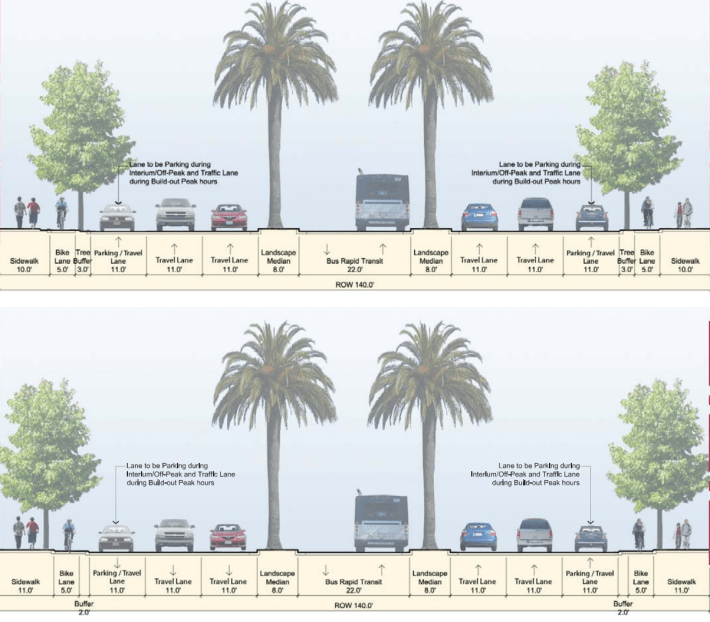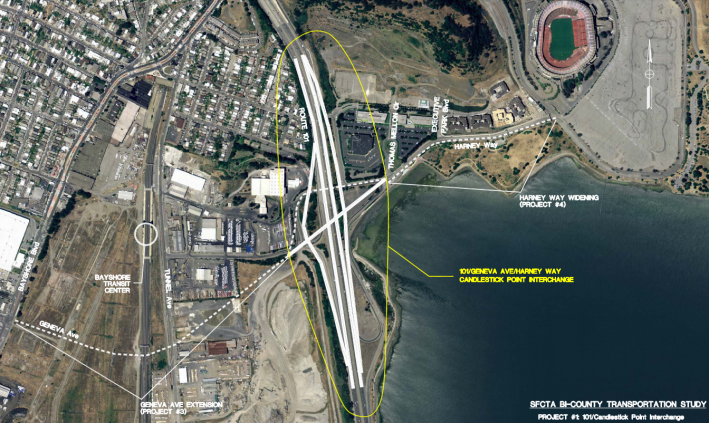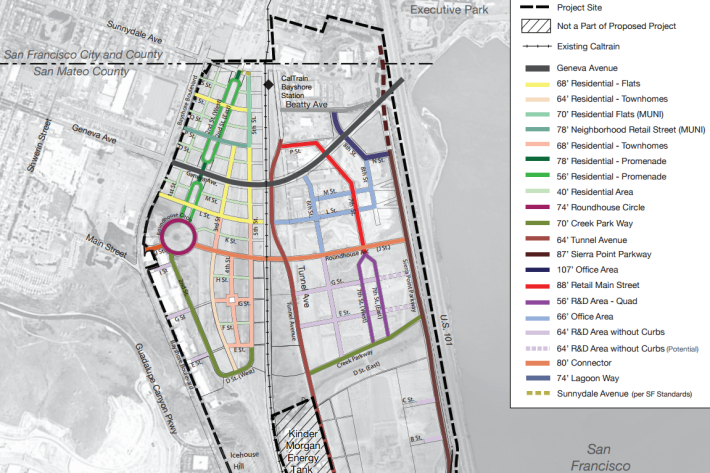
As the City of Brisbane agonizes over how little housing to include in a new mixed-use mega development to be built around a relocated Bayshore Caltrain Station, proposals to sink over $300 million into a new 12-lane Highway 101 interchange and an eight-lane extension of Geneva Avenue remain uncontroversial.
If approved, 7 million square feet of new office and retail space will be built on a huge abandoned rail yard and municipal dump, attracting an estimated 15,500 to 17,500 weekday workers. A proposed 4,434 new residential units would house around 9,900 new residents, although the inclusion of these housing units have proven the most controversial aspect of the plan.
Despite pitching the Brisbane Baylands as a transit-oriented community featuring an "improved street network to minimize traffic volume," city planners assume that even in 2030, 80 percent of the development's work trips and 70 percent of non-work trips will be made by automobile. 80 percent of visitors arriving at a 17,000-seat entertainment arena are also expected to arrive by car.
These mode shares are based on recent travel patterns observed around other Caltrain stations, which Brisbane simply assumes will remain unchanged for the next 14 years. Such an assumption ignores the reality that faster and more frequent electric trains, which Caltrain hopes to be running by 2021, will shift more trips to transit. Continued bike improvements will also contribute to mode shift.

Brisbane's Baylands plan maximizes auto traffic by building mostly wide, mutli-lane streets within the new development, expanding major intersections within Brisbane, and by connecting a wide new Geneva Avenue to a massively overbuilt Highway 101 interchange. On top of crossing eight lanes of auto and bus traffic spanning 120 feet on Geneva Avenue to reach the future Bayshore Intermodal Transit Station, and climbing a new overpass on Geneva Avenue to cross the Caltrain tracks, people walking or bicycling will face a number of other built-in barriers and hazards.
"If the Geneva Extension/Overpass is intended as the main bicycle and pedestrian connection to Caltrain, this would force these vulnerable modes to use a wide, heavily-trafficked arterial and contend with voluminous on-ramp and through traffic of freeway-bound cars and trucks," wrote the San Francisco Municipal Transportation Agency (SFMTA) in its comment letter on the Bayland's draft environmental review.
Even the development's narrowest residential streets will be 64 feet wide, nearly twice as wide as traditional walkable neighborhood streets located near other Caltrain stations in San Mateo County. Sidewalks vary in width from six to 10 feet, while standard (non-buffered or separated) bike lanes between five and six feet wide are specified, located in the door zones of parallel parked cars.

According to estimates [PDF] in the Bi-County Transportation Study of 2011, the proposed 12-lane interchange at Harney Way on the San Francisco-San Mateo border will cost $195 million, while building a new eight-lane Geneva Avenue from that interchange to Bayshore Boulevard will cost $90 million. A new $58 million Bayshore Intermodal Transit Station will be built south of today's Bayshore Caltrain Station, to be served by Caltrain, an extended T-Third Street Muni Metro line, and express buses running between the Balboa Park BART Station to the west and the Hunters Point Shipyard to the northeast.
After discussing the Brisbane Baylands Plan at 24 separate meetings over the past year, the city's Planning Commission is scheduled to issue its final recommendations to the City Council at its final review on August 25. City Council meetings to review the plan are not yet scheduled.





